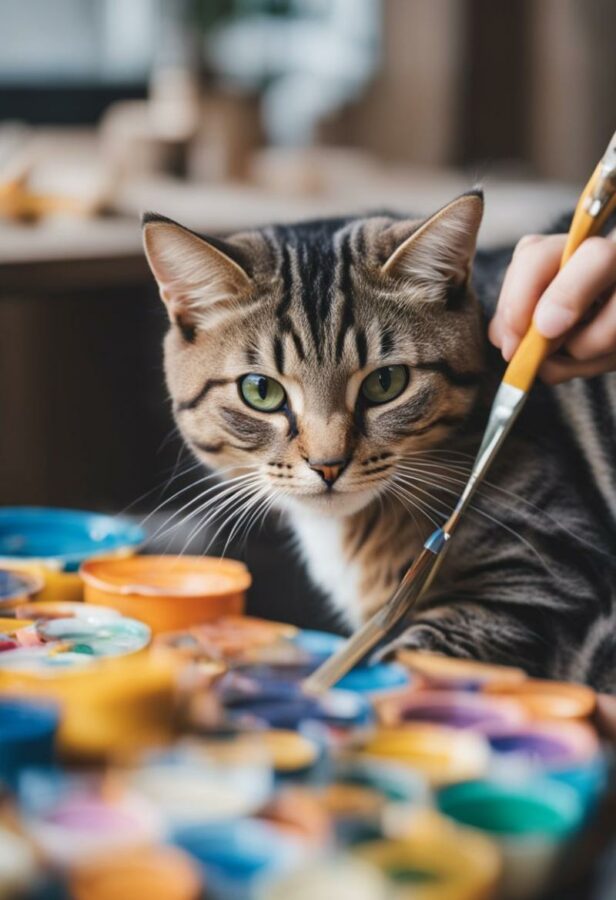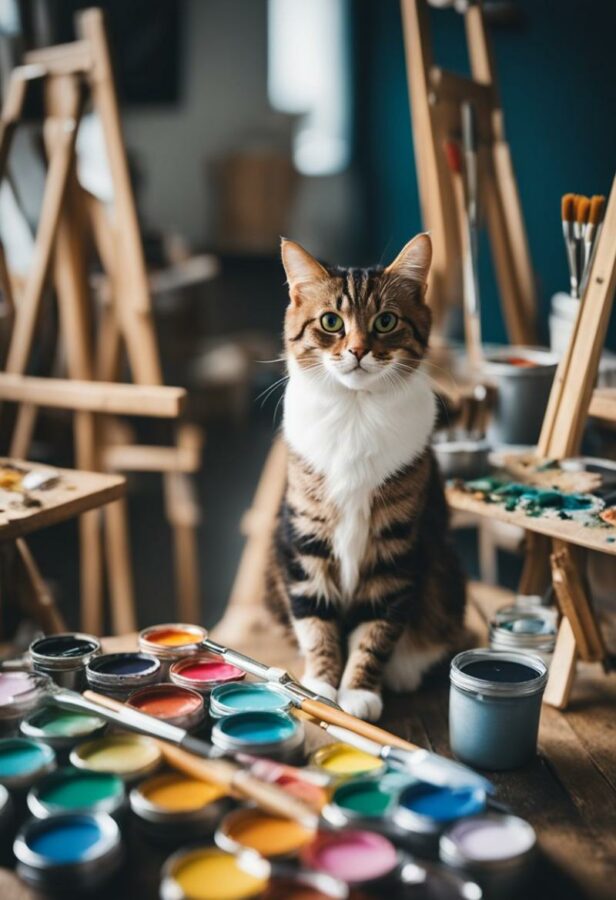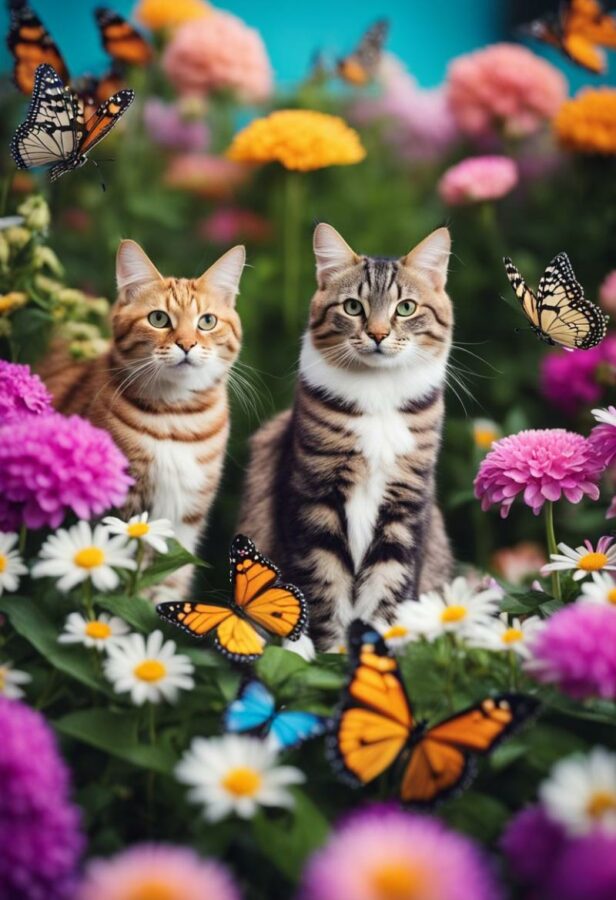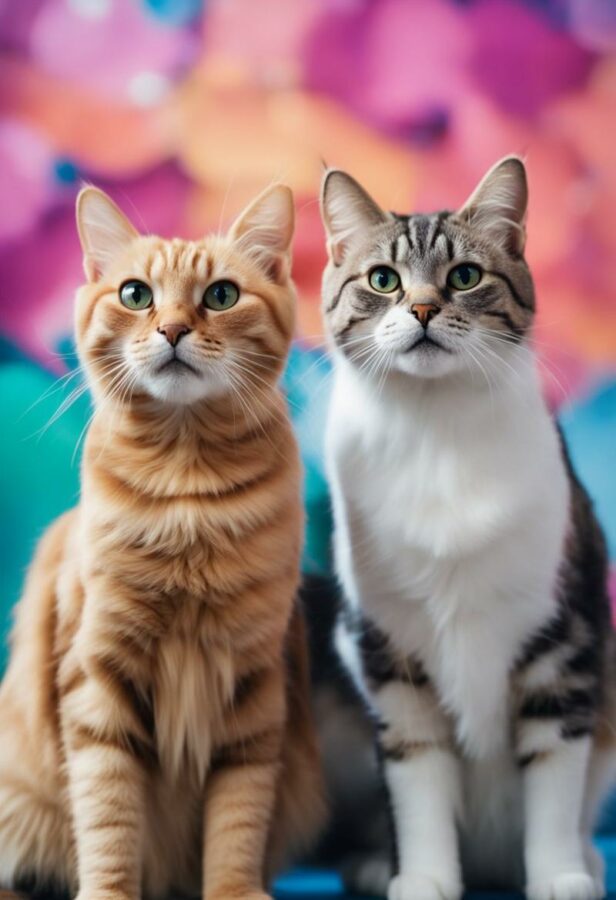The artistic allure of felines has captivated hearts and brushes for centuries. Your fascination might begin with the enigmatic poise of the white cat, or perhaps it’s the inscrutable gaze of the black cat that inspires you to capture its essence on canvas. Cat paintings, a subgenre of art in their own right, bridge the gap between pet lovers and art aficionados. From the playful strokes depicting cute cats’ antics to the meticulous detail in a realistic cat portrait, these artworks are as diverse as the creatures that inspire them.

When you set out to paint a cat, you’re not just brushing colors onto a surface; you’re breathing life into a tradition that has been perfected over generations. Whether it’s the charm of cats in paintings, like the whisker-fine detailing found in famous cat paintings, or the sheer joy of creating a piece that speaks of your love for these enigmatic animals, the process is as rewarding as its outcome. You may find yourself studying the subtleties of fur textures and the interplay of light and shadow to bring forth a depiction that’s truly your own.
As you explore the realms of feline-inspired art, remember that each brushstroke is a dialogue with history and a step towards mastering the representation of your muse. From understanding the posture and personality of your furry subject to choosing the right palette for its coat, every decision you make adds to the narrative of cats in art. So grab your brushes, summon your inner artist, and let your canvas reflect the splendor of these beloved pets.
Paws and Palettes

When you brush your artistic talents across the canvas, let your muse be the feline grace embodied in kittens. Imagine capturing the softness of cat fur, paying close attention to the way the light touches each strand, creating highlights that bring your artwork to life. As you consider your palette, think of the rich variety of colors found in the feline world—from the deep black fur of some majestic cats to the bold colors of others.
Begin with the eyes, the windows to the soul of these creatures, often shimmering with luminescence. Your brush strokes can convey the emotion and depth of those piercing gazes. Then, consider the pose; cats are known for their poise and the delicate balance they maintain in their every stance. Transferring this to your canvas requires a careful study of their effortless equilibrium.
Table 1: Cat Color Palette Inspiration
Fur Color | Associated Colors for Artwork |
|---|---|
Black fur | Cool greys, silvers, muted blues to enhance highlights |
White fur | Warm ivories, soft yellows for sunny glow |
Orange fur | Rich ambers, rusts for vibrancy |
Calico | Combination of earth tones, greens, and creams |
Work with light to its fullest by noticing how it casts shadows and defines muscles and bones beneath the layers of fur, revealing structure and form. The subtleties are vital; they bring realism and character to your kittens on paper.
Embrace the detail in the fur patterns, the uniqueness of markings, and let your art celebrate these extraordinary creatures. Whether it’s a single kitten or a playful gathering, your canvas is the stage for feline beauty. Engage with bold colors or restrained hues to express the essence and personality of your feline subjects. Your art, underpinned by an artistic understanding of these elegant animals, will resonate with an authenticity that only true appreciation can forge.
Colorful Catscapes

As you traverse the vibrant realm of cat-inspired art, you immerse yourself in the Colorful Catscapes. These are not your everyday pet portraits; they are imaginative landscapes where whiskered inhabitants become one with their environment. Your canvas beckons you to explore such fusion, where felines and nature intertwine in harmonious splendor.
- Begin with a nod to yesteryear’s masters like Horatio Henry Couldery, who painted cats with such detail and care, often highlighted in domestic, yet idyllic settings.
- Venture into the bold hues of Franz Marc, whose Expressionism laid the pathway for cats in modern art, transforming them into abstract forms amidst vivid backdrops.
Imagine translating the playfulness of felines into the whimsical strokes of Impressionist style, capturing the ethereal fluff of their coats and the soft glow in their eyes. Enrich your palette with watercolor paint to achieve delicate gradients, or perhaps opt for the vibrant potency of acrylics to state your artistic intent boldly.
In the spirit of Marc Chagall, let surrealism guide your brush; think of cats floating above towns ala “The Fiddler”, rewriting the physics of your canvases. Or, take a leaf from Pablo Picasso and experiment with Cubism, portraying the multifaceted persona of cats in fragmented reality.
Art Movement | Paint Choice | Artistic Goal |
|---|---|---|
Impressionism | Watercolor | Capture light and fleeting expressions |
Surrealism | Acrylics/Oil | Express dream-like, fantastical scenes |
Cubism | Mixed Media | Fragment and reconstruct form |
You tread the boundary of the ordinary into a world where landscapes are not just seen but felt. Every brushstroke enhances the connection between the creature and the scene, celebrating modern art‘s ability to push the envelope. Your pursuit echoes the sentiments of bold experimentation, making Colorful Catscapes not just a subject but a testament to feline grace and the eternal allure of artistic imagination.
See Related: Inked Whiskers: 25 Unique Cat Tattoo Designs
Feline Figures

In the realm of art, cats have been both muses and subjects, represented by artists from diverse cultural backgrounds and artistic periods. From historical portraits of aristocratic pets to modern abstract interpretations, you’ll discover the significance of felines in art through the works of renowned artists.
Historical Feline Figures
Through the centuries, cats have featured prominently in art, often symbolizing luxury, mystery, or playfulness. French artist Louis-Léopold Boilly’s painting “Gabrielle Arnault as a Child” exemplifies this through the delicate depiction of a child’s innocence alongside a cat, embodying the elegance of the turn-of-the-century. Similarly, the English artist Horatio Couldery’s work “Curiosity” captures the playful nature of cats, a theme that resonates with your own interests in capturing the whimsical side of life.
Delving into the more distant past, Japanese artist Utagawa Hiroshige II’s “A White Cat Playing with a String” demonstrates the timeless appeal of these creatures, as they play a role within the rich tapestry of Japanese woodblock prints. From the Renaissance period, although not exclusively focused on feline subjects, Leonardo da Vinci’s sketch studies of various animals might inspire you to explore the elegance and agility of cats through your art.
Artist | Artwork Title | Notable Aspect |
|---|---|---|
Louis-Léopold Boilly | Gabrielle Arnault as a Child | Portrayal of Childhood alongside Feline |
Horatio Couldery | Curiosity | Cats in Whimsical Themes |
Utagawa Hiroshige II | A White Cat Playing with a String | Japanese Woodblock Print |
Leonardo da Vinci | Animal Sketch Studies | Studies of Animal Movement |
Contemporary Feline Figures
In contemporary art, cats continue to inspire with their grace and mystery. American artist Mary Cassatt’s “Sara Holding A Cat” sheds light on her Impressionist style, where the bond between a child and her pet is rendered in thick, blunt brush strokes. The inclusion of cats in her compositions might encourage you to consider how the presence of an animal can offer a deeper glimpse into personal relationships.
Delve into the work of Pierre Bonnard, a French post-Impressionist artist, whose paintings often include cats as part of the domestic landscape, inviting you to involve cats as an element to express the comfort of home life.
Artist | Artwork Title | Size | Notation |
|---|---|---|---|
Mary Cassatt | Sara Holding A Cat | Small | Intimacy of Human-Pet Relationship in Impressionism |
Pierre Bonnard | Various Works | Varying | Cats within Domestic Spaces |
As you create, let the size, style, and individuality of each artist’s approach remind you that your canvas holds limitless possibilities for interpreting the ever-inspiring feline figure.
Whisker Workshops

Embark on a journey of feline finesse, where Whisker Workshops guide you through the delicate art of capturing cat whiskers on canvas. Your artistic touch can bring each strand to life with mesmerizing clarity and length.
To begin, gather your brushes and envision the elegant strokes needed to mimic the fine detail of whiskers. Use masking tape to create a boundary around your intended whisker area for added precision. This acts as your barrier, much like a skilled barber shop creates perfect lines without affecting surrounding hair—only here, it’s for the delicate filaments on a cat’s face.
Step by step, learn to execute fluid, confident strokes that start thin at the root, swelling slightly to indicate strength, then tapering again to a wispy point. As suggested by Lachri, an underpainting technique can provide a solid base for your intricate whisker work. You can experiment with whisker length and direction, just as a fanciful scene might depict a barber shop with monkeys and cats, merging reality with the whimsy of imagination.
Remember, each whisker is a testament to your patience and attention to detail. Should you find yourself dissatisfied with the stroke, simply allow the paint to dry and carefully lift the errant whisker with a clean brush—revealing the pristine underpainting, ready for your next attempt.
Allow the expressive nature of your artistic soul to explore the symphony of lines and textures, creating whiskers that are as lifelike as they are a testament to your dedication to the canvas.
Kitty Collages

As an artist, you may find an enriching avenue for creative expression by crafting kitty collages. The process of assembling various materials into a composite work allows for an exploration of texture, color, and form centered around the feline form, which has been endearingly depicted in art for centuries, from the stately renderings of cats in ancient Egypt to the whimsical works of Le Chat Noir.
When you embark on creating a kitty collage, consider the legacy of feline representation in art. Artists like Henriëtte Ronner-Knip with “The Cat’s Lunch” and Julie Manet with Cat, a piece illustrating the bond between a girl and her pet, exemplify the warmth cats bring into human lives. Marguerite Gérard’s “A Young Girl with Cat” or Edgar Degas during the Impressionist period have also offered a glimpse into the cat’s place in domestic life through their paintings.
Artistic Elements to Explore:
Component | Consideration in Kitty Collages |
|---|---|
Texture | Utilize the tactile element to mimic cat fur. |
Color | Choose a palette that reflects the cat’s vibrancy. |
Form | Capture the cat’s fluidity and poise. |
Expression | Show the curiosity inherent in feline nature. |
To experiment with anthropomorphic themes, reflect on works like “The Bachelor Party,” where the artist infuses human characteristics into cat subjects, offering a playful twist to your collage.
Steps to Begin:
- Gather Materials: Consider recycled magazines or varied paper types.
- Sketch Ideas: Draw inspiration from artists like Julius Adam or Hiroshige II.
- Assembly: Place your elements thoughtfully, building up layers.
Remember, your collage could take a surreal turn à la Mr. Matt McCarthy’s creations or embrace the traditional cut-and-paste approach shown in various online tutorials. The key is to let your creativity and love for all things cats guide your artwork’s direction. Whether you choose to depict “The Cat at Play” or a serene scene of “A White Cat Playing with a String,” the result is sure to captivate any lover of cats and art.